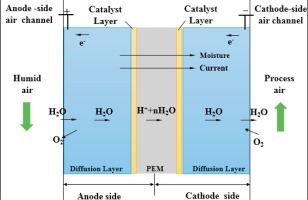Applied Energy ( IF 11.2 ) Pub Date : 2017-09-15 , DOI: 10.1016/j.apenergy.2017.09.035 Ronghui Qi , Dujuan Li , Li-Zhi Zhang

|
An electrochemical air dehumidification system with polymer electrolyte membrane (PEM) was developed. The system performance under various operating conditions was investigated experimentally. A semi-empirical prediction model was also developed with multi-parameter linear regressions. Results showed that the novel system could dehumidify the air flow, with a humidity decrease from 90% (inlet) to less than 30% RH (outlet) under a 3 V electric field, which is promising as it can achieve an independent, portable and energy-efficient moisture removal. The steady-state dehumidification performance derived was 80 kg/(kW h·m2), or 54 kg/(h·V·m2), which were advantageous to current electrochemical dehumidifiers. Specially, this simple element has a volume of only 0.001–0.01‰ of traditional ones, which is also suitable for cascading or multilevel assembly to satisfy various requirements for commercial and industrial applications. The moisture transfer, mainly caused by the electrolysis (+), electro-osmosis (+) and back diffusion (−), increased significantly with the increases in anode-side air humidity and flow rates. When the inlet air humidity increased from 70 to 90%, the dehumidification rate increased about 1.5–2 times. However, only 30% of total power input was effectively used in current element, and the rests were lost, leading to a relatively low system COP (≈0.33). The main reason was that the back-diffusion mass transfer was found to be up to 2.3 times larger than expected, causing by the high moisture content in cathode-side layers (mainly the diffusion layer), which seriously deteriorated the system performance. Therefore, enhancing the diffusion layer performance may help to optimize the dehumidification efficiency effectively. The suggested measures include improving the structure, changing the internal surface parameters or adding microporous layers, etc.
中文翻译:

基于聚合物电解质膜的电化学空气除湿系统的性能研究
开发了一种带有聚合物电解质膜(PEM)的电化学空气除湿系统。实验研究了在各种操作条件下的系统性能。还开发了具有多参数线性回归的半经验预测模型。结果表明,该新型系统可对空气流进行除湿,在3 V电场下,其湿度从90%(入口)降低到30%RH(出口)以下,这是有希望的,因为它可以实现独立,便携式和高效的运行。高效除湿。得出的稳态除湿性能为80 kg /(kW h·m 2)或54 kg /(h·V·m 2)),这对当前的电化学除湿机是有利的。特别是,这种简单元件的体积仅为传统元件的0.001–0.01‰,也适用于级联或多层组装,以满足商业和工业应用的各种要求。随着阳极侧空气湿度和流速的增加,主要由电解(+),电渗(+)和反向扩散(-)引起的水分传递显着增加。当进气湿度从70%增至90%时,除湿率提高了约1.5–2倍。但是,只有30%的总功率输入有效地用于电流元件,其余的都丢失了,从而导致系统COP相对较低(≈0.33)。主要原因是发现反向扩散传质比预期大2.3倍,由阴极侧层(主要是扩散层)中的高水分含量引起的,这严重恶化了系统性能。因此,增强扩散层性能可以帮助有效地优化除湿效率。建议的措施包括改善结构,更改内表面参数或添加微孔层等。


























 京公网安备 11010802027423号
京公网安备 11010802027423号